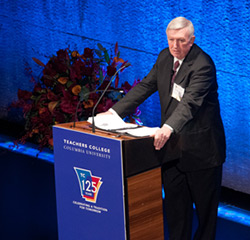How Wealth and Philanthropy Created the New Cultural Capitol of the World
In his keynote address at the New York Historical Society on opening night event for the exhibit "Teachers College: Pioneering Education through Innovation Pioneering Education," Kenneth T. Jackson, Columbia University's Jacques Barzun Profess or of History and Director of the Herbert H. Lehman Center for American History, began with a paean to Teachers College's primary founder and guiding spirit, Grace Hoadley Dodge.
Keynoting for TC at the New York Historical Society, Columbia historian Kenneth Jackson describes the birth of modern-day American philanthropy and its enduring impact on the world’s greatest city:
“Yes, she was rich and well-born – but so were a lot of other people, and precious few of them ever had such an enduring impact on this country. From the YWCA to the Travelers Aid Society to the effort to protect vulnerable young women from prostitution – what was then called ‘white slavery’ – to Teachers College itself, Grace Dodge seemed to be everywhere at the same time, not just with her money, but with her time, her dedication, her leadership and her passion.”
In his keynote address at the New York Historical Society on opening night event for the exhibit “Teachers College: Pioneering Education through Innovation Pioneering Education,” Kenneth T. Jackson, Columbia University’s Jacques Barzun Profess or of History and Director of the Herbert H. Lehman Center for American History, began with a paean to Teachers College’s primary founder and guiding spirit, Grace Hoadley Dodge. But as far-reaching as her individual accomplishments were, Jackson argued, Dodge – whose grandfather was William E. Dodge, co-founder of Phelps-Dodge and Company, the great mining company founded after the Civil War – also embodied the much broader phenomenon of public-spirited good works that was born during the Gilded Age in New York City and that has come to characterize modern-day American philanthropy.
The New York into which Dodge conjured TC was not only older than any other American city, but was also in the process of becoming the cultural capitol of the nation and, in many ways, the world. In part that emergence occurred through a new critical mass in the arts, best symbolized by William Dean Howells, then the dean of American writers and newly arrived in Gotham from Boston. But even more important, Jackson said, was that “the great wealth of the nation began gathering here” – a glittering constellation of powerful families that included the Dodges, the Astors (on his death bed, in 1848, John Jacob Astor, said that given a second chance, he’d have purchased every available square foot of the island of Manhattan), the Vanderbilts, the Rockefellers (John D. Rockefeller “could have bought Downton Abbey for pocket change”), the Morgans, the Fricks, and the Carnegies.
These first citizens “initiated the great American tradition of public-private philanthropy,” Jackson said, quoting Andrew Carnegie’s dictum that “a man who dies thus rich dies disgraced.”
The generosity of these families led to the creation of enduring New York City institutions that ranged from TC to the Brooklyn Bridge to the Metropolitan Museum of Art. The result was that, “ultimately New York City surpassed London, Paris, Berlin, Vienna and Rome,” not to mention all other cities in the United States, doubling the size of its nearest American competitor. Perhaps most compelling of all, Jackson said, New York was truly cosmopolitan, with “more Irish than Dublin, more Italians than Naples” and more Jews than any other place in the world.
“Never before or since have so many people from so many different locations crowded together,” Jackson said.
Of course, no age lasts forever, and New York would fall upon harder times. When Jackson himself first arrived in 1968, the city was in decline, beset by spiraling crime rates, racial tensions and a bitter teachers strike that lasted for the better part of a year. Brooklyn alone lost more than 300,000 residents during a 10-year period, “white flight” was general and corporations were moving their headquarters to other locales. Yet New York has since risen again, buoyed in no small part by the institutions created in the latter part of the 19th century. The public schools have improved dramatically, crime rates have dropped to once-unthinkable lows, a new wave of immigration has revitalized the city – and, perhaps most promisingly, a new wave of philanthropy is focusing on education more than any other single venue for local and national improvement.
Jackson closed by harking back to The History of Teachers College, the 1952 volume ins which Lawrence Cremin, the Pulitzer-prize winning education historian and TC’s seventh president, argued that Grace Dodge’s particular genius lay in her emphasis on “manual and practical education, professional training and the study of education.
“’She saw them all as a means to better homes, better children, better communities, better morals,” Jackson said, quoting Cremin. “’In a word, to a better world.’”
Published Thursday, Mar. 7, 2013
